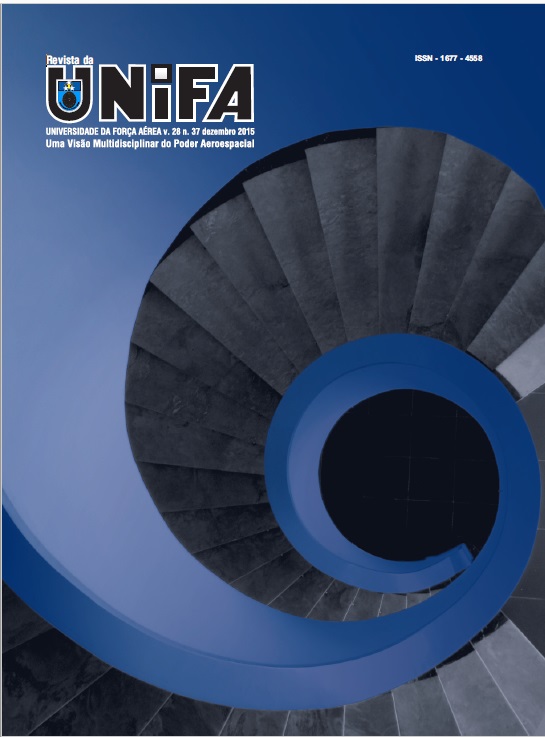Making quick decisions
an investigation on the relationship between multiple tasks and impulsiveness
DOI:
https://doi.org/10.22480/revuinfa.%25y.v28.442Keywords:
Multiple tasks, Impulsivity, Decision makingAbstract
This article is part of a research project that aims to contribute to the training of military pilots, specifically training for quick decisions. The starting point of the research is the aptitude test for military pilot (TAPMIL), which assesses learning potential candidate for military pilot with a view to flight instruction conducted in the Air Squadrons Instruction Air Force Academy (AFA) . It is a fully computerized psychological test consisting of a battery of six tests that assess, independently or combined, inherent in piloting skills as "cognitive skills" (eg, information processing, speed and accuracy of responses, working memory ) and ability to "multitask" (psychomotor and cognitive combined) (Costa, 2010, p.6). Are sought evidence for assigning weights to the different variables involved in the problem of fitness (Silva et al., 2009) which leads us to choose - until now - as featured in the ability multitasking variable. The focus in the variable 'multitask' has led us to new investigative lines, as studies on human judgment in decisions, particularly those taken in dynamic environments with a large uncertainty (Klein, 2009), and the relationship between the ability to perform multiple tasks and impulsivity. Therefore, in order to continue this investigative line about the correlation between multiple tasks and impulsivity, this paper aims to present the results of two tests performed with the Brazilian Air Force cadets, airmen of the class of 2011 in a total 60 volunteers. To check the ability to perform multiple tasks, we used the test "all at once" (Herculano-Houzel, 2014). And with 45 volunteers to test impulsivity used the Barratt Impulsiveness Scale - 11 BIS.
References
ARAÚJO, M. M.; MALLOY-DINIZ, L. F.; ROCHA, F. L. Impulsividade e acidentes de trânsito.
Revista de Psiquiatria Clínica, v. 36, n. 2, p. 60-68, 2009.
BAZERMAN, M. H. Judgment in managerial decision making. 6th ed. Hoboken: J. Wiley & Sons, 2006.
COSTA, M. P. Estudo de normatização e validação do teste de aptidão para a pilotagem
militar. 2010. Dissertação (Mestrado) - Instituto de Psicologia, Universidade de São Paulo, 2010.
DAVEL, E.; VERGARA, S. C. (Org.). Gestão com pessoas e subjetividade. São Paulo: Atlas, 2001.
FÁVERO, L. P. et al. Análise de Dados: modelagem multivariada para tomada de decisões. Rio de Janeiro: Elsevier, 2009.
KLEIN, G. Sources of power: how people make decisions. Cambridge: MIT, 2000.
MALLOY-DINIZ, L. F. et al. lmpulsiveness scale (BIS-11) para aplicação em adultos brasileiros. Jornal Brasileiro de Psiquiatria, Rio de Janeiro, v. 59, n. 2, p. 99-105, 2010.
HERCULANO-HOUZEL, S. O cérebro nosso de cada dia. Rio de Janeiro: FAPERJ: CNPQ, 2000.
Disponível em:< http://www.cerebronosso.bio.br/guiabsico-de-neurocincia>. Acesso em: 5 mar 2014.
PATTON, J. H.; STANFORD, M. S.; BARRATT, E.S. BIS-11 instrument reference. Factor structure of the
Barratt impulsiveness scale. Journal of Clinical Psychology, v. 51, n. 6, p. 768-774. Disponível em:
<http://www.impulsivity.org/measurement/bis11>. Acesso em: 25 mar. 2014.
SANBONMATSU, D. M et al. Who multi-tasks and why? Multi-tasking ability, perceived multi-tasking ability, impulsivity, and sensation seeking. PSO ONE, v. 8, n. 1, jan. 2013.
SILVA, L. M. A.; LUCAS, L. A.; COSTA, M. P. Analysis of decision making processo flight instructors at the Brazilian Air Force Academy. ln: INTERNATIONAL CONFERENCE ON NATURALISTIC DECISION MAKING, 9., 2009,
London. Proceedings of ... London: [s .n.], 2009.
Published
How to Cite
Issue
Section
License
Copyright (c) 2022 The Journal of the University of the Air ForceRevista da UNIFA permite que o (s) autor (es) mantenha(m) seus direitos autorais sem restrições. Atribuição-NãoComercial 4.0 Internacional (CC BY-NC 4.0) - Revista da UNIFA é regida pela licença CC-BY-NC









